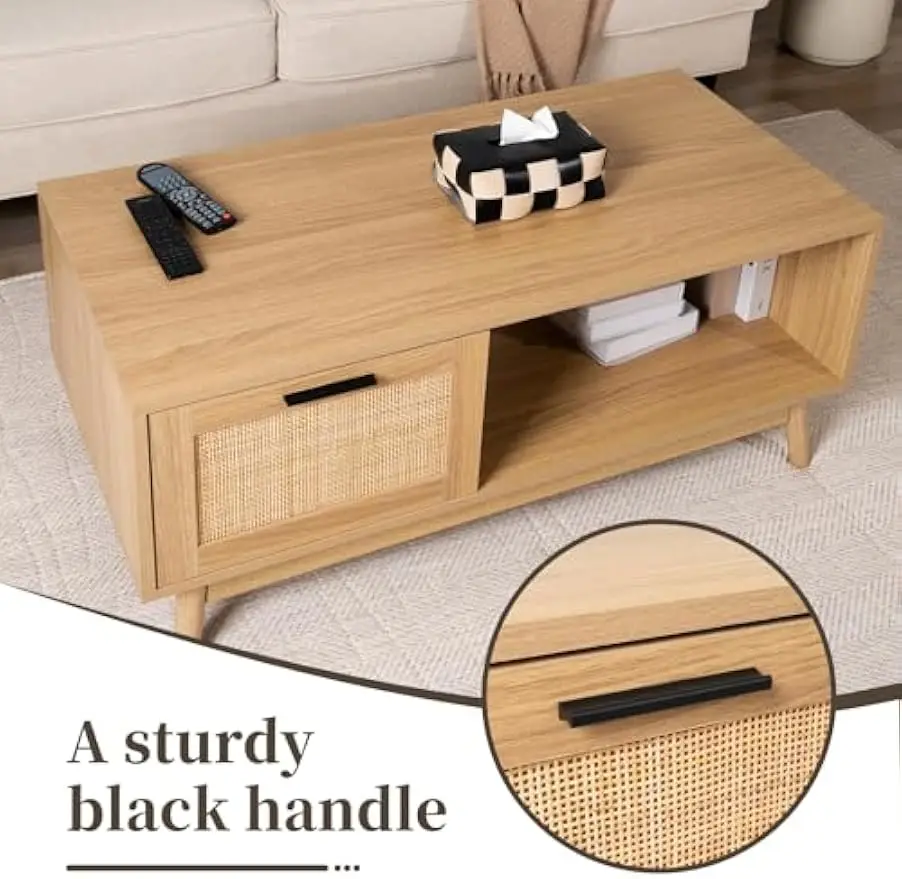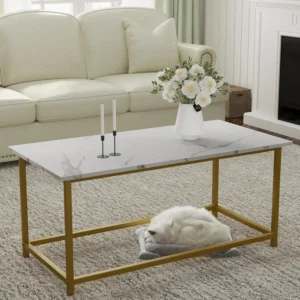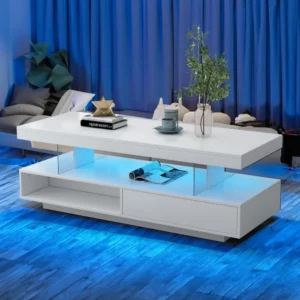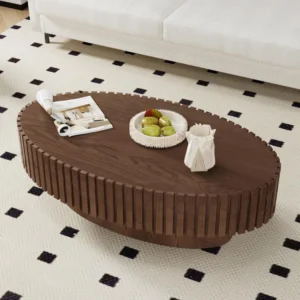Introduction: The Timeless Appeal of Solid Wood Coffee Tables
Solid wood coffee tables stand apart in the world of furniture as enduring centerpieces that blend beauty with function. Unlike their mass-produced counterparts made from engineered materials, solid wood tables offer unmatched durability, with many pieces becoming cherished heirlooms passed down through generations. Each table tells its own story through unique grain patterns, natural color variations, and subtle imperfections that give it character impossible to replicate.
The appeal of solid wood extends beyond aesthetics. These tables represent a sustainable choice when sourced responsibly, bringing a touch of nature into our living spaces. As an investment piece, a quality solid wood coffee table often appreciates in value over time while particleboard alternatives deteriorate.
What makes solid wood coffee tables truly special is their versatility across interior design styles. From the clean lines of intelligent black mid-century coffee tables to rustic farmhouse pieces, there’s a solid wood table to complement any décor. This guide explores the most popular styles, helping you discover which aesthetic best suits your space and personal taste.
Popular Solid Wood Coffee Table Styles for Every Interior
Mid-Century Modern: Timeless Elegance with Clean Lines
Mid-century modern design emerged in the mid-20th century and has maintained its popularity for good reason. This style perfectly balances form and function with an emphasis on clean lines, organic shapes, and minimal ornamentation. Mid-century modern coffee tables are instantly recognizable by their distinctive features:
- Tapered or splayed legs that create a sense of lightness
- Organic shapes that flow naturally, often with rounded edges
- Simple, unadorned surfaces that highlight the wood’s natural beauty
- Low profile designs that complement the era’s furniture proportions
Woods like walnut, teak, and oak are the stars of this style, chosen specifically for their rich grain patterns and warm tones that develop a beautiful patina over time. The natural characteristics of these woods are celebrated rather than concealed.
At Hearth Forms, these principles are central to our design philosophy, with an emphasis on authentic proportions and quality construction that honors true mid-century principles. Mid-century modern solid wood coffee tables pair beautifully with various interior styles, making them adaptable to both contemporary and traditional spaces. Many homeowners find that understanding which styles go well with mid-century modern helps create cohesive, sophisticated interiors.
Farmhouse: Rustic Charm for Casual Living
Farmhouse style coffee tables bring warmth and unpretentious charm to living spaces, evoking the cozy comfort of rural life. This increasingly popular style emphasizes authenticity and a lived-in quality that makes spaces feel immediately welcoming.
Key design elements include:
– Sturdy, substantial construction built to withstand daily use
– Rustic or distressed finishes that show character and age
– Simple, practical designs often featuring X-braces or turned legs
– Plank tops that showcase the wood’s natural texture
Pine, oak, and reclaimed timber are the woods of choice for farmhouse coffee tables, often featuring knots, saw marks, and other “imperfections” that add to their authentic character. Finishes range from natural stains that highlight the wood grain to whitewashed or painted surfaces for a more country-cottage feel.
Modern farmhouse variations incorporate cleaner lines and more refined finishes while maintaining rustic elements, offering a perfect balance for those who appreciate the style but prefer a more contemporary interpretation.
Industrial: Raw Materials and Urban Appeal
Industrial coffee tables draw inspiration from factory and warehouse spaces, celebrating the raw beauty of utilitarian design. These pieces make bold statements in any room through their honest materials and functional aesthetic.
Distinctive features include:
– Mixed material construction combining wood with metal elements
– Exposed hardware like bolts, rivets, and brackets
– Mechanical components such as wheels, casters, or adjustable heights
– Weathered or distressed finishes that suggest history and use
Reclaimed wood plays a starring role in industrial coffee tables, often paired with blackened steel, brass, or cast iron. The wood softens what might otherwise be a harsh metal-dominated piece, creating balance through contrast. Dark-stained mango wood and other rich-toned varieties complement the typically darker metal finishes.
For added functionality in smaller spaces, mid-century modern lift-top coffee tables offer storage solutions while maintaining industrial appeal through their mechanical elements.
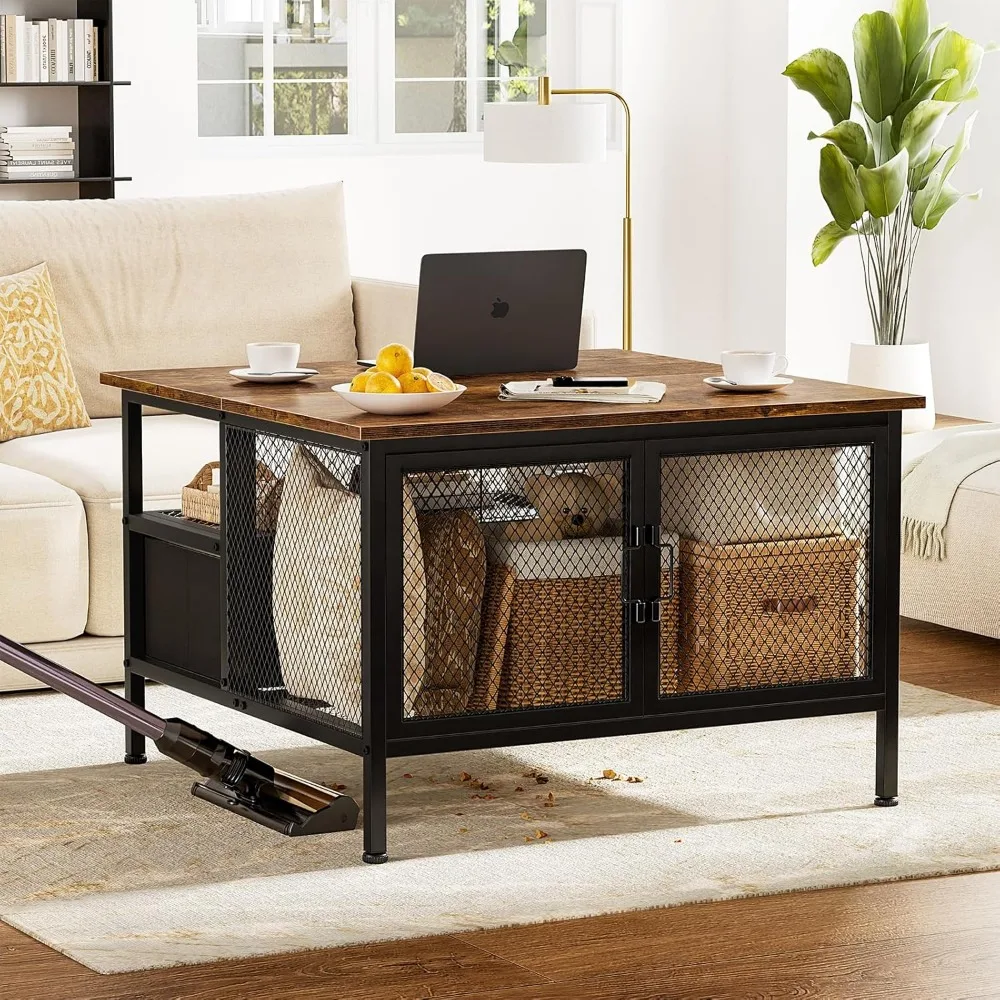
Scandinavian: Minimalist Beauty with Light Woods
Scandinavian design brings light, air, and simplicity into living spaces, embodying the Nordic concept of “hygge” (pronounced hoo-gah)—a quality of coziness and comfortable conviviality. These coffee tables focus on clean lines, functional simplicity, and honest materials.
Key characteristics include:
– Light-colored woods that brighten spaces
– Streamlined silhouettes without excess ornamentation
– Rounded edges and softened corners
– Slim, often angled legs that create visual lightness
Ash, birch, light oak, and maple are preferred for their pale tones and subtle grain patterns. Finishes tend to be matte or satin rather than high-gloss, preserving the wood’s natural look and tactile qualities.
Scandinavian coffee tables excel at creating bright, airy spaces while maintaining warmth through natural materials. For those drawn to this aesthetic, mid-century modern white coffee tables offer similar light-filled qualities while incorporating some mid-century elements.
Live Edge: Celebrating Natural Wood Forms
Live edge coffee tables represent perhaps the purest celebration of wood’s natural beauty. These distinctive pieces feature at least one edge left intact from the original tree, complete with natural contours, bark inclusions, or interesting irregularities.
What makes live edge tables special:
– One-of-a-kind organic shapes impossible to replicate
– Dramatic grain patterns and natural features highlighted as focal points
– Contrast between polished surfaces and natural edges
– Celebration of the wood’s origin and growth patterns
Walnut is particularly prized for live edge pieces due to its rich coloration and striking grain, though oak, maple, and redwood are also popular choices. These slabs are typically paired with simple metal hairpin legs, solid wood bases, or glass supports that don’t compete with the wood’s natural drama.
Each live edge table is inherently unique, making it not just furniture but a conversation piece and natural art form. For those interested in learning more about various wood types and their characteristics, our ultimate guide to solid wood coffee tables provides valuable insights.
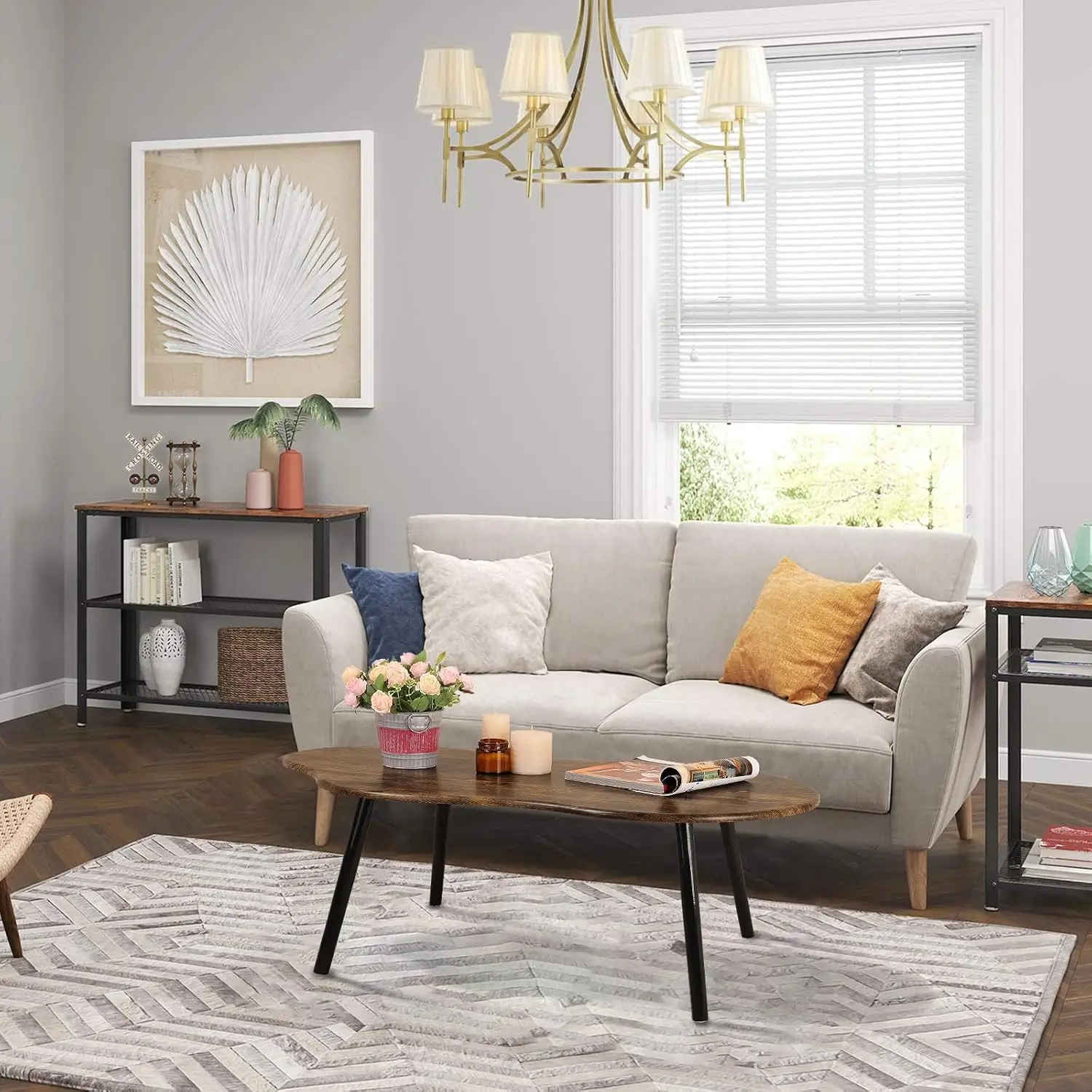
Traditional: Classic Elegance with Rich Woods
Traditional coffee tables draw inspiration from historical European furniture styles, offering timeless elegance and refined craftsmanship. These pieces often feature more ornate details than other styles, creating a sense of formality and sophistication.
Distinguishing features include:
– Carved decorative elements like scrollwork or fluting
– Cabriole legs with curved shapes
– Inlay work or marquetry for visual interest
– Rich, deep finishes that highlight the wood’s formal character
Mahogany, cherry, and walnut are favored for their rich color and ability to take detailed carving. These woods develop a beautiful patina over decades, often becoming more valuable with age. Finishes tend to be polished to a warm luster rather than matte or distressed.
Traditional coffee tables excel in formal living spaces and pair beautifully with classic upholstered furniture. Their enduring design principles have influenced furniture making for centuries, making them truly timeless options.
Contemporary: Modern Simplicity with Clean Finishes
Contemporary coffee tables represent current design trends rather than a specific historical period. These pieces focus on clean lines, innovative forms, and often incorporate new materials or manufacturing techniques alongside wood.
Key elements include:
– Geometric or asymmetrical shapes that make bold statements
– Sleek, smooth surfaces with minimal texture
– Innovative combinations of wood with glass, metal, or stone
– Emphasis on visual impact and originality
Walnut, oak, and maple remain popular choices but are typically given smooth, uniform finishes that downplay rather than highlight natural variations. The wood is often precisely cut with machine-perfect edges and joints that showcase modern craftsmanship.
Contemporary designs frequently push boundaries with cantilever effects, unexpected proportions, or innovative storage solutions. For inspiration on incorporating these modern pieces into your space, exploring black mid-century coffee table design can offer valuable insights on blending contemporary and classic elements.
Choosing the Right Solid Wood Coffee Table for Your Space
Materials Matter: Understanding Wood Types and Finishes
The type of wood you choose for your coffee table significantly impacts its appearance, durability, and how it ages over time. Each species brings its own characteristics to your living space:
| Wood Type | Characteristics | Best For | Color/Tone |
|---|---|---|---|
| Walnut | Rich grain, naturally dark, excellent durability | Mid-century, contemporary, high-end designs | Deep brown with purple/chocolate undertones |
| Oak | Strong, prominent grain, very durable | Farmhouse, traditional, rustic styles | Light to medium brown with visible grain |
| Maple | Smooth, consistent grain, very hard | Scandinavian, contemporary, minimalist | Pale cream to light reddish-brown |
| Cherry | Smooth grain, darkens beautifully with age | Traditional, formal settings | Reddish-brown that deepens over time |
| Teak | Naturally oily, extremely durable, water-resistant | Mid-century modern, outdoor-indoor pieces | Golden to medium brown |
| Pine | Soft, knotty, casual appearance | Farmhouse, rustic, budget-friendly options | Very light yellow-white to amber |
The finish applied to the wood also dramatically affects both appearance and maintenance requirements. Oil finishes penetrate the wood and enhance natural character but require regular maintenance. Lacquers and polyurethane create protective barriers that are more durable but can look more manufactured. Wax finishes offer a low-luster, natural appearance that’s easily refreshed.
For those particularly interested in the rich, distinctive qualities of walnut, our collection of mid-century modern walnut coffee tables showcases this premium wood’s versatility.
Form and Function: Size, Shape, and Features
Finding the perfect coffee table involves balancing size, shape, and functionality with your specific space and needs:
Size Considerations:
– Height: Ideally 1-2 inches lower than your sofa seat cushions
– Length: Approximately two-thirds the length of your sofa
– Clearance: Allow 12-18 inches between the table and seating for comfortable movement
Shape Options:
– Rectangular: The most traditional choice, works well in most spaces
– Round: Ideal for smaller rooms or homes with young children (no sharp corners)
– Square: Makes a statement in larger spaces or centered between multiple seating areas
– Oval: Combines the flow of round tables with the functionality of rectangular ones
Many modern coffee tables incorporate functional features that maximize their utility. These might include drawers for storing remote controls, lift-tops that create impromptu work surfaces, or shelves for displaying books and magazines.
For more guidance on selecting the perfect shape for your space, our article on square versus round coffee table layouts offers practical advice for making this important decision.
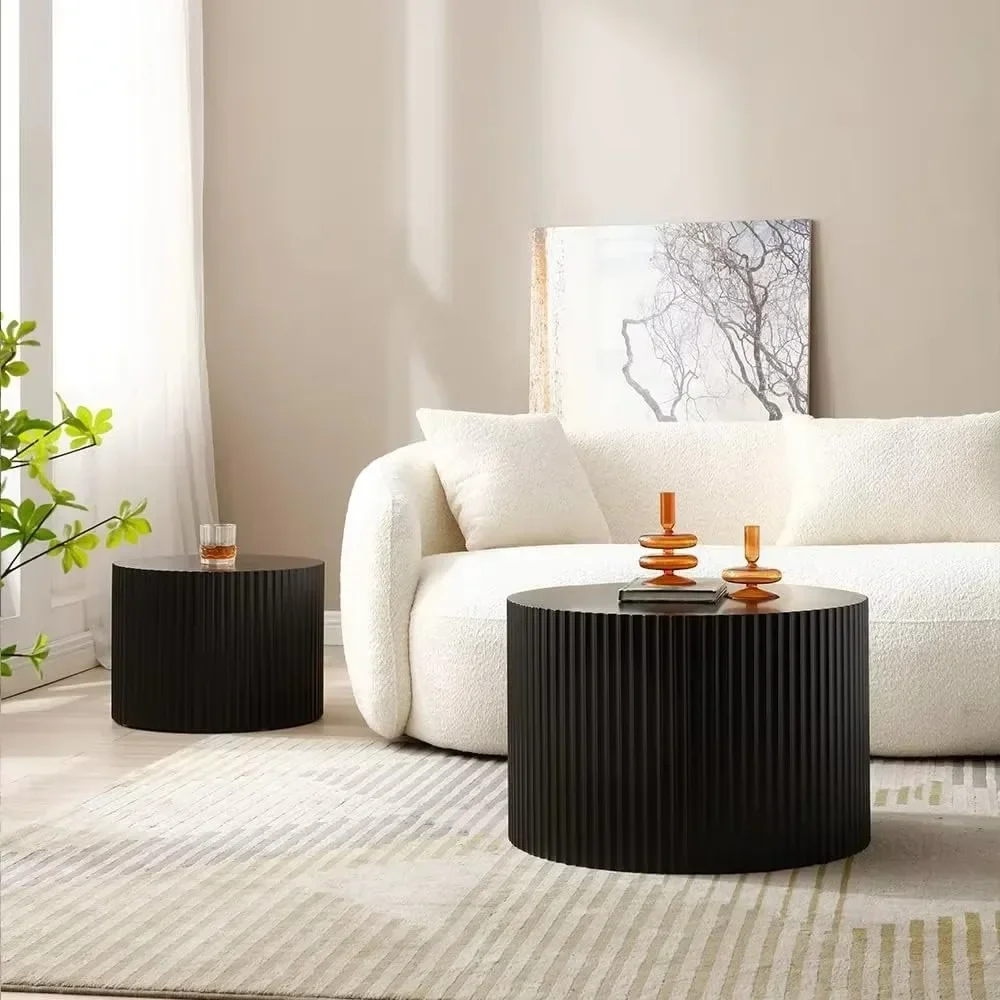
Design Harmony: Pairing Your Coffee Table with Existing Furniture
Creating a cohesive look involves understanding how your coffee table relates to your existing furniture pieces:
Tips for Harmonious Design:
– Match wood tones within two shades for a coordinated look
– Create intentional contrast by pairing light tables with darker furniture (or vice versa)
– Echo design elements—if your sofa has clean lines, choose a table with similar qualities
– Consider proportions—substantial furniture needs a coffee table with presence
You don’t need to match all wood finishes exactly—in fact, a thoughtfully mismatched look often has more character. Instead, look for complementary undertones. For example, woods with warm undertones (cherry, mahogany) pair well together, as do those with cool undertones (ash, some maples).
Your coffee table can serve as either a statement piece or a supporting element. In rooms with bold furniture or dramatic art, a simpler table lets those elements shine. Conversely, a distinctive coffee table can be the focal point in a room with more subdued furnishings.
For specific ideas on highlighting your coffee table, our guide to styling black mid-century coffee tables provides inspiration applicable to many styles.
Mid-Century Modern Solid Wood Coffee Tables, Mid-Century Modern Teak Coffee Tables
$879.95 Select options This product has multiple variants. The options may be chosen on the product pageMid-Century Modern Danish Coffee Tables, Mid-Century Modern Oval Coffee Tables, Mid-Century Modern Solid Wood Coffee Tables
$390.05 Select options This product has multiple variants. The options may be chosen on the product pageMid-Century Modern Lift Top Coffee Tables, Mid-Century Modern Square Coffee Tables
$454.73 Select options This product has multiple variants. The options may be chosen on the product pageMid-Century Modern Marble Top Coffee Tables, Mid-Century Modern Rectangular Coffee Tables, Mid-Century Modern White Coffee Tables
Price range: $163.28 through $189.22 Select options This product has multiple variants. The options may be chosen on the product pageMid-Century Modern Rectangular Coffee Tables, Mid-Century Modern White Coffee Tables
$605.68 Select options This product has multiple variants. The options may be chosen on the product pageMid-Century Modern Oval Coffee Tables, Mid-Century Modern Solid Wood Coffee Tables
$679.56 Select options This product has multiple variants. The options may be chosen on the product page
Caring for Your Solid Wood Coffee Table
Maintaining Natural Beauty: Cleaning and Protection
Proper care ensures your solid wood coffee table remains beautiful for generations:
Daily Care:
– Dust regularly with a soft, lint-free cloth
– Clean spills immediately to prevent staining
– Use coasters, placemats, and trivets to protect against moisture and heat
– Maintain consistent humidity levels to prevent wood from expanding or contracting
Cleaning Methods:
– For regular cleaning, wipe with a slightly damp cloth followed by a dry one
– For deeper cleaning, use mild soap diluted in water (test in an inconspicuous spot first)
– Avoid commercial sprays containing silicone, which can build up over time
– Apply a quality wood conditioner or polish every few months based on finish type
Different finishes require different care approaches. Oil-finished tables benefit from occasional re-oiling, while lacquered surfaces need protection from alcohol and harsh chemicals that can damage their protective layer. Always know what finish your table has before applying any products.
Restoring and Refreshing: When and How to Refinish
Even well-maintained wood tables may eventually need refreshing:
Signs it’s time for attention:
– Dull, lifeless appearance despite regular cleaning
– Water rings that don’t respond to gentle remedies
– Scratches that have penetrated the finish
– Uneven color or worn patches in high-use areas
For minor issues, simple refreshers like lemon oil or commercial wood rejuvenators can restore luster. Scratches can often be minimized with touch-up markers or sticks matched to your wood tone, while deeper ones might require wood filler before refinishing.
Complete refinishing—stripping, sanding, and reapplying finish—is a more involved process best left to professionals for valuable pieces. However, many solid wood tables can be successfully refinished by careful DIYers with proper research and patience.
Current Trends in Solid Wood Coffee Tables
The world of solid wood coffee tables continues to evolve while honoring traditional craftsmanship:
Emerging Design Trends:
– Mixed materials combining wood with marble, brass, or concrete
– Multifunctional designs with storage, lift-tops, or convertible features
– Contrasting wood tones within a single piece
– Sculptural forms that function as art pieces
Sustainability has moved from niche concern to mainstream priority, with consumers increasingly valuing responsibly sourced wood, zero-waste production methods, and non-toxic finishes. Many manufacturers now provide transparency about sourcing and environmental impact.
Color trends show growing interest in both extremely light woods (ash, maple) and very dark varieties (ebonized oak, dark walnut), with fewer medium-toned pieces. This contrast reflects broader interior design trends toward more dramatic statements.
For current styling approaches, our guide to decorating black mid-century coffee tables offers inspiration that can be adapted across styles.
Why Choose a Solid Wood Coffee Table? The Enduring Benefits
The advantages of investing in a solid wood coffee table extend far beyond aesthetics:
Durability is perhaps the most compelling benefit—quality solid wood furniture can last for generations with proper care, while engineered alternatives typically need replacement within 5-10 years. This longevity makes solid wood pieces more economical over time despite higher initial cost.
Environmental benefits are significant when wood is responsibly sourced. Unlike synthetic materials derived from petroleum, wood is renewable and biodegradable. Solid wood furniture has a substantially smaller carbon footprint, especially when crafted to last decades rather than years.
Perhaps most importantly, solid wood coffee tables offer a connection to nature and craftsmanship increasingly rare in our mass-produced world. Each piece carries the natural beauty of the tree it came from, with unique grain patterns and character that tell a story no factory-made alternative can match.
By choosing solid wood, you’re not just buying furniture—you’re investing in a piece with potential to become tomorrow’s heirloom, growing more beautiful with each passing year.

